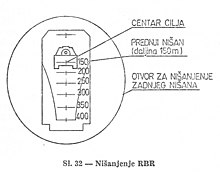
A rocket-propelled grenade (RPG) is a shoulder-fired rocket weapon that launches rockets equipped with an explosive warhead. Most RPGs can be carried by an individual soldier, and are frequently used as anti-tank weapons. These warheads are affixed to a rocket motor which propels the RPG towards the target and they are stabilized in flight with fins. Some types of RPG are reloadable with new rocket-propelled grenades, while others are single-use. RPGs are generally loaded from the front.

The Mk 153 Shoulder-Launched Multipurpose Assault Weapon (SMAW) is a smoothbore shoulder-fired rocket launcher. It is a portable assault weapon and has a secondary anti-armor ability. Developed from the B-300, it was introduced to the United States Armed Forces in 1984. It has a maximum effective range of 500 metres (550 yd) against a tank-sized target.

The M79 Osa is a Yugoslav-made portable 90 mm anti-tank weapon made of fibre-reinforced plastics. It resembles the French portable anti-tank launcher 89 mm LRAC F1. It consists of the launcher, a CN-6 sighting piece, rocket and carrying case for the rocket. The M79 shoots unguided projectiles in direct sight and is effective against armoured fighting vehicles and fortifications.

The M72 LAW is a portable one-shot 66 mm (2.6 in) unguided anti-tank weapon.

The LAW 80, regularly referred to as LAW 94 in British service, is a man-portable, disposable anti-tank weapon previously used by the British Army and a few other militaries.

The RPO-A Shmel is a man-portable, single-use, rocket-assisted thermobaric weapon. While its name directly translates to flamethrower, the RPO-A Shmel is more accurately described as a thermobaric weapon. The Shmel is designed, produced and exported by the Russian Federation and previously by the Soviet Union. It entered service with the Soviet Armed Forces at the end of the 1980s as the successor for the RPO Rys.

The M-87 Orkan is a Yugoslav fully automated self-propelled multiple rocket launcher. The generic M-87 project was configured with 12 launch tubes mounted on a FAP 2832 truck. It has a range of about 50 to 120 km, with the ability to deliver warheads, anti-tank and anti-personnel mines. The production of Orkan M-87 ceased in the early 1990s due to breakup of Yugoslavia.
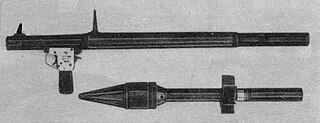
The RPG-2 is a man-portable, shoulder-fired anti-tank weapon that was designed in the Soviet Union. It was the first successful anti-tank weapon of its type, being a successor to the earlier and unsuccessful rocket-propelled grenade RPG-1.

The 9M14 Malyutka is a manual command to line of sight (MCLOS) wire-guided anti-tank guided missile (ATGM) system developed in the Soviet Union. It was the first man-portable anti-tank guided missile of the Soviet Union and is probably the most widely produced ATGM of all time—with Soviet production peaking at 25,000 missiles a year during the 1960s and 1970s. In addition, copies of the missile have been manufactured under various names by at least six countries.
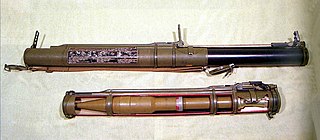
The RPG-18 Mukha is a Soviet short-range, disposable light anti-tank rocket launcher designed in 1972. It was based on the M72 LAW.

The Soviet RPG-22Netto is a one-shot disposable anti-tank rocket launcher first deployed in 1985, based on the RPG-18 rocket launcher, but firing a larger 72.5 mm fin stabilised projectile. The weapon fires an unguided projectile, can be prepared to fire in around 10 seconds, and can penetrate 400 mm of armour, 1.2 metres of brick or 1 metre of reinforced concrete.

The PF-89 or Type 89 is a portable, disposable, unguided, shoulder-launched, anti-tank rocket-propelled rocket launcher. Developed by Norinco for the People's Liberation Army (PLA), the PF-89 was designed to replace the obsolete Type 69 RPG, providing a man-portable, single-use assault weapon system that could be used mainly by infantry squads to engage and defeat light armor and bunkers.

The LRAC F1, officially called Lance-Roquettes AntiChar de 89 mm modèle F1, is a French reusable rocket launcher developed by Luchaire Défense SA, and manufactured in cooperation with Manufacture Nationale d'Armes de Saint-Étienne and was, in the 1970s, marketed by Hotchkiss-Brandt.

The M141 bunker defeat munition (BDM) is a disposable single-shot, shoulder-fired rocket launcher designed to defeat hardened structures. It is a modification of the United States Marine Corps Mk 153 shoulder-launched multipurpose assault weapon (SMAW) and is also called the SMAW-D. It was designed to fill the void in the United States Army inventory of a "bunker buster" weapon.

The RBR-120 mm M90 is a light-weight, single-use, unguided anti-tank rocket launcher. The launcher is produced by Eurokompozit of Prilep, North Macedonia and Poliester of Priboj, Serbia, while the anti-tank rocket is produced by Sloboda of Čačak, Serbia. It is intended for use against tanks and other armoured vehicles in addition to fortifications and infantry.
RPG-76 Komar is a disposable one-shot anti-tank grenade launcher that fires an unguided anti-tank rocket-propelled grenade. The weapon was designed as a smaller and lighter alternative to the RPG-7, especially for use by airborne troops. Thanks to jet nozzles located between the warhead and the fuel compartment, it can be fired from inside of a building or a vehicle.
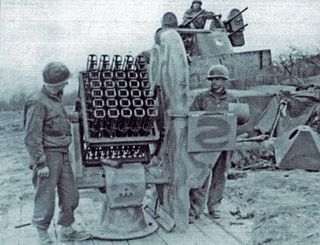
The Henschel Hs 297 Föhn or 7.3 cm Raketen Sprenggranate was a small German surface-to-air rocket of the Second World War. The associated multiple rocket launcher was known as the 7.3 cm Föhn-Gerät.

The AT4 is a Swedish 84 mm (3.31 in) unguided, man-portable, disposable, shoulder-fired recoilless anti-tank weapon manufactured by Saab Bofors Dynamics. The AT4 is not a rocket launcher strictly speaking, because the explosive warhead is not propelled by a rocket motor. Rather, it is a smooth-bore recoilless gun. Saab has had considerable sales success with the AT4, making it one of the most common light anti-tank weapons in the world. The M136 AT4 is a variant used by the United States Army.
The FT5 is a shoulder-launched, unguided and portable anti-tank rocket weapon. The weapon was built in South Africa by Somchem, a division of Denel based in Somerset West, now Rheinmetall Denel Munition. The weapon was designed with the primary function to provide soldiers with a weapon capable of destroying armoured fighting vehicles and modern main battle tanks. The weapon also has a secondary function of destroying bunkers and other fortifications.
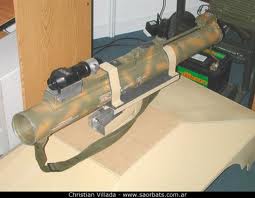
The MARA is a portable one-shot 78 mm unguided anti-tank weapon, designed and manufactured in Argentina by Fabricaciones Militares (DGFM). The solid rocket propulsion unit was developed by CITEFA.


